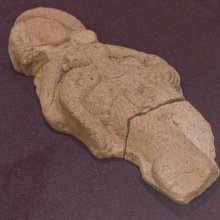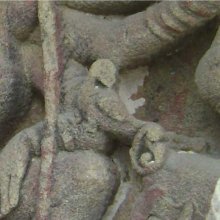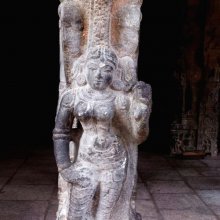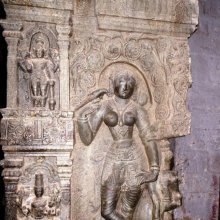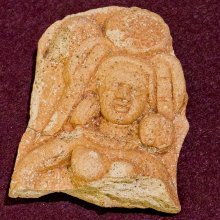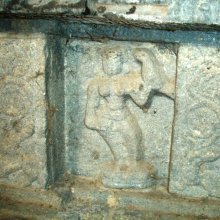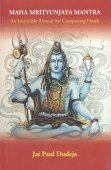Parrot: 5 definitions
Introduction:
Parrot means something in Buddhism, Pali, Hinduism, Sanskrit, the history of ancient India. If you want to know the exact meaning, history, etymology or English translation of this term then check out the descriptions on this page. Add your comment or reference to a book if you want to contribute to this summary article.
Images (photo gallery)
(+10 more images available)
In Hinduism
Purana and Itihasa (epic history)
Source: Shodhganga: Elements of Art and Architecture in the Trtiyakhanda of the VisnudharmottarapuranaParrots and Mynas were traditionally trained (to speak and sing), as part of the “sixty four kinds of Art”, according to the Kamasutra of Vatsyayana.—Cf. the Sanskrit Śukasārikāpralāpana.—Indian tradition, basically includes sixty four Art forms are acknowledged. The history of Indian Art covers approximately five thousand years which presents a rich and almost continuous record. The references of sixty four kinds of Kala (कला, kalā) are found in the Bhagavatapurana, Shaiva-Tantras, Kamasutra of Vatsyayana etc.

The Purana (पुराण, purāṇas) refers to Sanskrit literature preserving ancient India’s vast cultural history, including historical legends, religious ceremonies, various arts and sciences. The eighteen mahapuranas total over 400,000 shlokas (metrical couplets) and date to at least several centuries BCE.
Natyashastra (theatrics and dramaturgy)
Source: Shodhganga: Elements of Art and Architecture in the Trtiyakhanda of the Visnudharmottarapurana (natya)1) The Parrot is denoted by the Sanskrit therm Śuka, whereas Śukatuṇḍa-hasta refers to one of the twenty-two Single-hand Gestures (in Indian Dramas) (known as asaṃyuktahastas), according to the Viṣṇudharmottarapurāṇa, an ancient Sanskrit text which (being encyclopedic in nature) deals with a variety of cultural topics such as arts, architecture, music, grammar and astronomy.—The word śukatuṇḍa is the amalgamation of two words viz., śuka and tuṇḍa. Śuka means parrot and tuṇḍa means head. So, the word śukatuṇḍa denotes the head of a parrot. In the Viṣṇudharmottarapurāṇa, the ring finger is suggested to be bent in the position of arālahasta to make the śukatuṇḍahasta. When the forefinger and the ring finger are curved in arālahasta, the two bend fingers make a curve shape which looks like the head of a parrot.
2) Parrots are also associated with Bhramara-hasta: another one of the twenty-two Single-hand Gestures.—The name of the posture bhramara itself identifies the shape of a bhramara i.e., a black bee. Abhinavagupta also admits it. [...] In the Abhinayadarpaṇa, this posture is said to denote bee, parrot, wing, crane, cuckoo etc.

Natyashastra (नाट्यशास्त्र, nāṭyaśāstra) refers to both the ancient Indian tradition (shastra) of performing arts, (natya—theatrics, drama, dance, music), as well as the name of a Sanskrit work dealing with these subjects. It also teaches the rules for composing Dramatic plays (nataka), construction and performance of Theater, and Poetic works (kavya).
Shilpashastra (iconography)
Source: Shodhganga: Elements of Art and Architecture in the Trtiyakhanda of the Visnudharmottarapurana (shilpa)The Parrot is associated with Agni (Vahni), whose iconography is described in the Viṣṇudharmottarapurāṇa, an ancient Sanskrit text which (being encyclopedic in nature) deals with a variety of cultural topics such as arts, architecture, music, grammar and astronomy.—According to the Viṣṇudharmottarapurāṇa, the image of Agni should be placed on a chariot adorned with the images of four parrots and a symbol of smoke. But in the Śilparatna, the image of Agni is instructed to be placed on the seat of a lotus. Thus it is clear that the Viṣṇudharmottarapurāṇa offers a great field of knowledge regarding the nuances of Indian art of Image making [e.g., the parrot] during 10th–11th century A.D.

Shilpashastra (शिल्पशास्त्र, śilpaśāstra) represents the ancient Indian science (shastra) of creative arts (shilpa) such as sculpture, iconography and painting. Closely related to Vastushastra (architecture), they often share the same literature.
In Buddhism
Tibetan Buddhism (Vajrayana or tantric Buddhism)
Source: academia.edu: The Structure and Meanings of the Heruka MaṇḍalaThe Parrot (animal) is associated with the Yoginī (female deity) named Sukī or Śukī, being situated in the Vāyucakra, according to the 10th century Ḍākārṇava-tantra: one of the last Tibetan Tantric scriptures belonging to the Buddhist Saṃvara tradition consisting of 51 chapters.—Accordingly, the vāyucakra refers to one of the three divisions of the dharma-puṭa (‘dharma layer’), situated in the Herukamaṇḍala. The 36 pairs of Ḍākinīs [viz., Sukī or Śukī—“Parrot”] and Vīras are dark blue in color; they each have one face and four arms; they hold a skull bowl, a skull staff, a small drum, and a knife.

Tibetan Buddhism includes schools such as Nyingma, Kadampa, Kagyu and Gelug. Their primary canon of literature is divided in two broad categories: The Kangyur, which consists of Buddha’s words, and the Tengyur, which includes commentaries from various sources. Esotericism and tantra techniques (vajrayāna) are collected indepently.
India history and geography
Source: Singhi Jain Series: Ratnaprabha-suri’s Kuvalayamala-katha (history)Parrots were commonly depicted on the Saṃsāracakra paintings (representing scenes of human life), in ancient India, as mentioned in the Kathās (narrative poems) such as Uddyotanasūri in his 8th-century Kuvalayamālā (a Prakrit Campū, similar to Kāvya poetry).—Page 185.21 f.: Here follows a description of a printed scroll illustrating the Jaina conception of saṃsāracakra. [...] The saṃsāra-cakra illustrated the three worlds of hell, human world and the world of gods. [For example:] Persons shooting animals with bow and arrow; a person holding a naked sword and showing feats of swordsmanship; parrots and magpies put in cages for amusement

The history of India traces the identification of countries, villages, towns and other regions of India, as well as mythology, zoology, royal dynasties, rulers, tribes, local festivities and traditions and regional languages. Ancient India enjoyed religious freedom and encourages the path of Dharma, a concept common to Buddhism, Hinduism, and Jainism.
See also (Relevant definitions)
Starts with: Parrot alstroemeria, Parrot flower, Parrot leaf, Parrot lily, Parrot tree, Parrotiopsis jacquemontiana, Parrotweed, Parrotwood.
Full-text (+454): Shuka, Kira, Shauka, Bahuja, Vakratunda, Rajashuka, Ciri, Vakranakra, Shuki, Shatapatra, Priyadarshana, Popata, Popatajnana, Kirakhada, Shukanasika, Aragili, Arasugili, Arasagili, Panjarashuka, Rajakira.
Relevant text
Search found 148 books and stories containing Parrot; (plurals include: Parrots). You can also click to the full overview containing English textual excerpts. Below are direct links for the most relevant articles:
Village Folk-tales of Ceylon (Sri Lanka), vol. 1-3 (by Henry Parker)
Story 34 - The Kinnara and the Parrots < [Part I - Stories told by the Cultivating Caste and Vaeddas]
Story 12 - The Black Storks’ Girl < [Part I - Stories told by the Cultivating Caste and Vaeddas]
Story 8 - The Prince And The Princess < [Part I - Stories told by the Cultivating Caste and Vaeddas]
The Jataka tales [English], Volume 1-6 (by Robert Chalmers)
Jataka 484: Sālikedāra-jātaka < [Volume 4]
Jataka 255: Suka-jātaka < [Book III - Tika-Nipāta]
Jataka 503: Sattigumba-jātaka < [Volume 4]
Puranic encyclopaedia (by Vettam Mani)
Vakyapadiya of Bhartrihari (by K. A. Subramania Iyer)
Verse 2.173 < [Book 2 - Vākya-kāṇḍa]
Verse 1.23 < [Book 1 - Brahma-kāṇḍa (or Āgama-samuccaya)]
Tiruvaymoli (Thiruvaimozhi): English translation (by S. Satyamurthi Ayyangar)
Pasuram 10.8.4 < [Section 8 - Eighth Tiruvaymoli (Tirumaliruncolai)]
Pasuram 9.5.4 < [Section 5 - Fifth Tiruvaymoli (Innuyirc cevalum)]
Pasuram 9.5.6 < [Section 5 - Fifth Tiruvaymoli (Innuyirc cevalum)]
The Religion and Philosophy of Tevaram (Thevaram) (by M. A. Dorai Rangaswamy)
Chapter 63 - Ciparppatam (Hymn 79) < [Volume 3.5 - Pilgrim’s progress: to the North]
Chapter 49-50 - Thirunindravur or Tiruninriyur (Hymn 65) < [Volume 3.4 - Pilgrim’s progress: with Paravai]
Chapter 78 - Thiruvarur or Tiruvarur (Hymn 37) < [Volume 3.6 - Pilgrim’s progress: away from Otriyur and Cankili]
Related products
